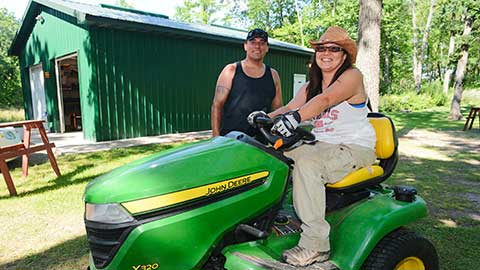Our Communities
The Mille Lacs Band’s reservation consists of three districts composed of several distinct communities that have existed in East Central Minnesota for hundreds of years. District I includes the main reservation area on the west side of Mille Lacs Lake, sometimes referred to as ‘Neyaashing’ or ‘The Point’ in the Anishinaabe language. District II includes the communities in Minisinaakwaang (East Lake), Sandy Lake, and Minnewawa near McGregor as well as the community of Chiminising in Isle on the south side of Mille Lacs, which we call District IIa. District III includes the Aazhoomog (Lake Lena) community near the St. Croix River east of Hinckley, as well as a large community of Band members living in Hinckley. In each community, the Band has created jobs for Band members and non-members alike and also provides programs and services to Band members.
Government
Today, the Mille Lacs Band of Ojibwe is proud of its democratically elected government, based on a division of powers, which includes legislative, executive and judicial branches.
As a sovereign government, the Mille Lacs Band of Ojibwe is responsible for providing services to meet the needs of its people, much like the State of Minnesota does for its residents. The Chief Executive appoints Commissioners to run Executive Branch departments, which provide services to Band members.
The Legislative Branch, also called the Band Assembly, is made up of three District Representatives and a Secretary/Treasurer, who is also the Speaker of the Band Assembly. The Legislative Branch also passes laws, allocates revenue, and ratifies appointments of commissioners.
The Judicial Branch interprets laws and hears appeals from the Band’s District Court.
Education
The Band provides members with educational opportunities from early childhood through college, with a special emphasis on Ojibwe language and cultural programming. The Department of Education is operated by a Commissioner under the direction of a School Board elected by Band members.
The Band operates the K-12 Nay Ah Shing Schools in District I and charter schools in District II and District III. The Band has also established Anishinaabe College (formerly Mille Lacs Tribal College) located at Nay Ah Shing Upper School. The college offers post-secondary classes through collaborative partnerships with both Central Lakes College and Fond du Lac Tribal and Community College.
Health
The Mille Lacs Band’s Department of Health and Human Services operates three clinics across the reservation to make high-quality health care available to Band members. The Band also offers public health services, behavioral health services, family services such as child welfare and foster care services, and community support services to assist Elders and Band members in need.
The Band also provides assisted living facilities to Elders in all three districts, as well as Circle of Health, an insurance program set up to help Band members with healthcare costs.
Community Development
The Community Development Department ensures that Band members’ housing and infrastructure needs are met. Since 1991, the Band has built more than 200 new homes and renovated many existing homes, providing a boost to the regional economy through the hiring of local businesses and laborers.
In addition to over $50 million in infrastructure improvements on its own reservation, the Mille Lacs Band has invested millions in improvements that serve the communities of East Central Minnesota, including a wastewater treatment facility serving the Garrison, Kathio, West Mille Lacs Lake Sanitary District.
Public Safety
The Band’s Department of Justice is led by the Solicitor General, who is appointed by the Chief Executive and ratified by the Band Assembly.
To ensure the safety and security of Band members and local communities, the Band has a Tribal Police Department with 20 full-time peace officers. The department sponsors programs including a neighborhood watch group, cops in school program, canine registration, and a child passenger safety seat program. The department also provides licensing for motor vehicles.
Environmental Stewardship
The Mille Lacs Band of Ojibwe enjoy an inter-connectedness with the land and an approach to environmental stewardship that takes into account how today’s decisions will impact the next seven generations. The following are some key environmental initiatives of the Mille Lacs Band:
The Mille Lacs Band’s Department of Natural Resources, under the leadership of its commissioner, works in collaboration with the Minnesota DNR to manage the fish populations and the overall health of the lake. The Band also participates as a member of the Great Lakes Indian Fish and Wildlife Commission (GLIFWC), which serves as an intra-tribal regulatory and enforcement agency for natural resources in the Treaty of 1837 Ceded Territory, which includes the East Central Minnesota region and Mille Lacs Lake. The Mille Lacs Band DNR also issues hunting and fishing licenses and permits to Band members and non-Band members that hunt and fish on tribal lands, and enforces related regulations on the reservation.
The hallmark environmental asset of the region is Mille Lacs Lake. As it has for hundreds of years, the Mille Lacs Band harvests walleye, perch and tullibee from Mille Lacs Lake each year in a tradition passed down through the generations. Harvesting allows tribal members to provide for the subsistence of the tribe. Because the walleye is such an important part of the Band’s heritage, and a staple food source for many of the tribe’s members, the Band is actively involved in the management of the ecology and health of Mille Lacs Lake and its walleye population.
When it was discovered that a failing water treatment system in the nearby city of Garrison was leading to water pollution in the lake, the Band used its resources to help secure funding for the construction of a new $21 million wastewater treatment facility.
The Mille Lacs Band of the Ojibwe Department of Natural Resources and the Minnesota DNR worked together to restore wild rice production to Lake Ogechie and the ecology of the Upper Rum River.
Additional environmental projects are undertaken by the Band’s DNR each year.

